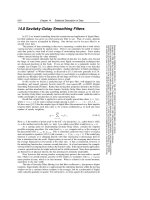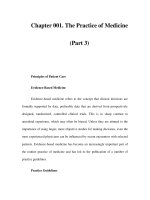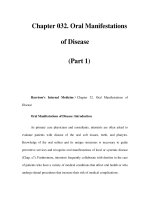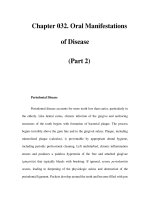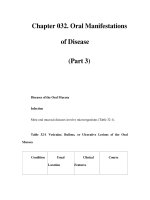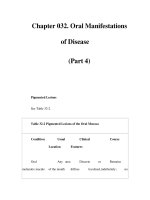Chapter 032. Oral Manifestations of Disease (Part 9) ppt
Bạn đang xem bản rút gọn của tài liệu. Xem và tải ngay bản đầy đủ của tài liệu tại đây (13.4 KB, 5 trang )
Chapter 032. Oral Manifestations
of Disease
(Part 9)
Dental Care of Medically Complex Patients
Routine dental care (e.g., extraction, scaling and cleaning, tooth restoration,
and root canal) is remarkably safe. The most common concerns regarding care of
dental patients with medical disease are fear of excessive bleeding for patients on
anticoagulants, infection of the heart valves and prosthetic devices from
hematogenous seeding of oral flora, and cardiovascular complications resulting
from vasopressors used with local anesthetics during dental treatment. Experience
confirms that the risks of any of these complications are very low.
Patients undergoing tooth extraction or alveolar and gingival surgery rarely
experience uncontrolled bleeding when warfarin anticoagulation is maintained
within the therapeutic range currently recommended for prevention of venous
thrombosis, atrial fibrillation, or mechanical heart valve. Embolic complications
and death, however, have been reported during subtherapeutic anticoagulation.
Therapeutic anticoagulation should be confirmed before and continued through the
procedure. Likewise, low-dose aspirin (e.g., 81–325 mg) can be safely continued.
Patients at high or moderate risk for bacterial endocarditis (Chap. 118)
should maintain optimal oral hygiene, including flossing, and have regular
professional cleaning. Prophylactic antibiotics are recommended for all at-risk
patients who undergo dental and oral procedures likely to cause significant
bleeding and bacteremia. Should unexpected bleeding occur, antibiotics given
within 2 h following the procedure provide effective prophylaxis.
Hematogenous bacterial seeding from oral infection can undoubtedly
produce late prosthetic joint infection and therefore requires removal of the
infected tissue (e.g., drainage, extraction, root canal) and appropriate antibiotic
therapy. However, evidence that late prosthetic joint infection occurs following
routine dental procedures is lacking. For this reason, antibiotic prophylaxis is not
recommended before dental surgery in patients with orthopedic pins, screws, and
plates. It is, however, advised within the first 2 years after joint replacement for
patients who have inflammatory arthropathies, immunosuppression, type 1
diabetes mellitus, previous prosthetic joint infection, hemophilia, or
malnourishment.
Concern often arises regarding the use of vasoconstrictors in patients with
hypertension and heart disease. Vasoconstrictors enhance the depth and duration
of local anesthesia, thus reducing the anesthetic dose and potential toxicity. If
intravascular injection is avoided, 2% lidocaine with 1:100,000 epinephrine
(limited to a total of 0.036 mg epinephrine) can be used safely in those with
controlled hypertension and stable coronary heart disease, arrhythmia, or
congestive heart failure. Precaution should be taken with patients taking tricyclic
antidepressants and nonselective beta blockers as these drugs may potentiate the
effect of epinephrine.
Elective dental treatments should be postponed for at least 1 month after
myocardial infarction, after which the risk of reinfarction is low provided the
patient is medically stable (e.g., stable rhythm, stable angina, and free of heart
failure). Patients who have suffered a stroke should have elective dental care
deferred for 6 months. In both situations, effective stress reduction requires good
pain control, including the use of the minimal amount of vasoconstrictor necessary
to provide good hemostasis and local anesthesia.
Bisphosphonate therapy can be associated with osteonecrosis of the jaw.
Most patients affected have received high dose aminobisphosphonate therapy for
multiple myeloma or metastatic breast cancer and have undergone tooth extraction
or dental surgery.
Intra-oral lesions appear as exposed yellow-white hard bone involving the
mandible or maxilla. Two-thirds are painful. Patients about to receive
aminobisphosphonate therapy should receive preventive dental care that reduces
the risk of infection and need for future dentoalveolar surgery.
Halitosis
Halitosis typically emanates from the oral cavity or nasal passages. Volatile
sulfur compounds resulting from bacterial decay of food and cellular debris
account for the malodor. Periodontal disease, caries, acute forms of gingivitis,
poorly fitting dentures, oral abscess, and tongue coating are usual causes.
Treatment includes correcting poor hygiene, treating infection, and tongue
brushing. Xerostomia can produce and exacerbate halitosis. Pockets of decay in
the tonsillar crypts, esophageal diverticulum, esophageal stasis (e.g., achalasia,
stricture), sinusitis, and lung abscess account for some instances.
A few systemic diseases produce distinctive odors: renal failure
(ammoniacal), hepatic (fishy), and ketoacidosis (fruity). Helicobacter pylori
gastritis can also produce ammoniac breath. If no odor is detectable, then
pseudohalitosis or even halitophobia must be considered. These conditions
represent varying degrees of psychiatric illness.
